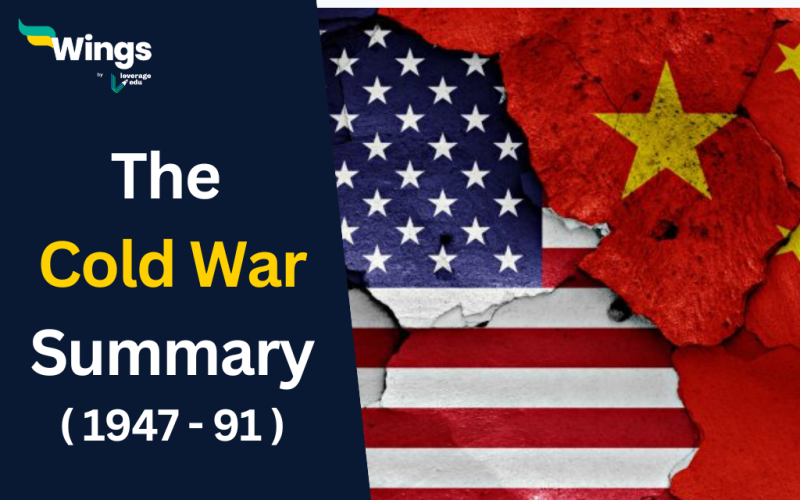The Cold War Summary: a period that had a major impact on world politics, ideologies, and military tactics. The Cold War, which lasted from World War II until the early 1990s, was characterised by fierce ideological competition between the United States and its allies and the Soviet Union and its allies. This blog discusses the timeline, causes, major events, and aftermath of the Cold War.
Table of Contents [show]
Pointers About the Cold War
- Following World War II, there was a time of geopolitical tension between the United States and the Soviet Union, as well as their respective allies, the Western Bloc and the Eastern Bloc.
- The US and USSR were never directly at odds with one another during the Cold War. In fact, aside from the nuclear arms race.
- So, the Space Race, espionage, proxy wars, Olympic sports rivalry, and propaganda were the main methods used to fight for global dominance.
- After the Soviet Union fell apart in 1991, the Cold War came to an end.
Why is this important for the UPSC exam?
The 30th anniversary of the fall of the Berlin Wall (which fell on 9/11/1989) was recently commemorated, which marked a watershed moment in the Cold War era.
Cold War: Causes
Initial conflict
- It was not ideology that led to the US and USSR’s alliance during World War II.
- Hitler’s violation of the non-aggression agreement he had signed with the Soviet Union, which resulted in significant territorial gains, compelled the Soviet Union to join the allied powers.
- Thus, at the end of the Second World War, the tense military alliance had started to fall apart and had started to take an entirely different direction.
Ideological Differences
- The rise of communism – In October 1917, the Bolshevik Revolution overthrew Russia’s Tsar and installed a “dictatorship of the proletariat” in his place.
- Capitalism and communism: ideological opposites – The political and economic systems of the capitalist USA and communist USSR were ideologically incompatible. Both sides wanted to affirm their model and force countries around the world to conform to their ideologies
- Germany disputes: At the Potsdam Conference in July 1945, the US, USSR, and Britain decided to partition Germany into four zones. One of the Allied powers, including France, was in charge of running each zone. The Western powers had visions of a prosperous, capitalist Germany that participated in international trade. On the other hand, Stalin wanted to ruin the German economy and make sure that Germany would never again be a powerful nation.
- Alliances were formed: the Western alliance was formalised into the North Atlantic Treaty Organisation (NATO), which was founded in April 1949. The Soviet Union headed the Eastern alliance, known as the Warsaw Pact. It was established in 1955, and its main purpose was to confront NATO forces in Europe.
- Nuclear arms race: Out of concern that they might lag behind in terms of research and production, the two superpowers raced to amass nuclear weapons. During the Cold War, more than 55,000 nuclear warheads were produced, along with nuclear weapons, reactors, bombers, submarines, missiles, and silos.
How did the Cold War end?
The Cold War came to an end, with the following series of events:
Split in the Eastern Bloc
- When the Soviet Union and China’s alliance broke down in the 1960s and 1970s, the Eastern Bloc’s unity began to break down.
- While this was happening, a few Western nations, including Japan, moved further away from the US economically.
- International relationships became more complicated as a result, which made it harder for smaller countries to win their support.
Gorbachev: Perestroika and Glasnost
- In the late 1980s, during Mikhail Gorbachev’s presidency, the Cold War finally started to end.
- He implemented reforms to divert attention away from the economic issues in the Eastern Bloc, where there was a shortage of goods.
- Perestroika, or “restructuring,” economic reforms, and Glasnost, or “openness,” a policy that loosens restrictions on free speech, were implemented to quell popular unrest.
- But these changes were introduced too late. As communist governments in Eastern Europe fell, democratic governments in East Germany, Poland, Hungary, and Czechoslovakia arose to take their place.
The Fall of the Berlin Wall
- In an effort to unite Germany, Germans on both sides of the Iron Curtain tore down the Berlin Wall in 1989.
- Anti-communist sentiment began to spread throughout the Eastern Bloc at the same time.
The collapse of the Soviet Union
- When the Soviet Union broke up into fifteen newly independent nations in 1991, the Cold War was officially over.
- The USSR changed its name to the Russian Federation and lost its communist ruler.
Hope you have gotten all the relevant information about the Cold War! If you want to know more about topics like this, then visit our general knowledge page! Alternatively, you can also read our blog on general knowledge for competitive exams!
 One app for all your study abroad needs
One app for all your study abroad needs















 45,000+ students trusted us with their dreams. Take the first step today!
45,000+ students trusted us with their dreams. Take the first step today!
